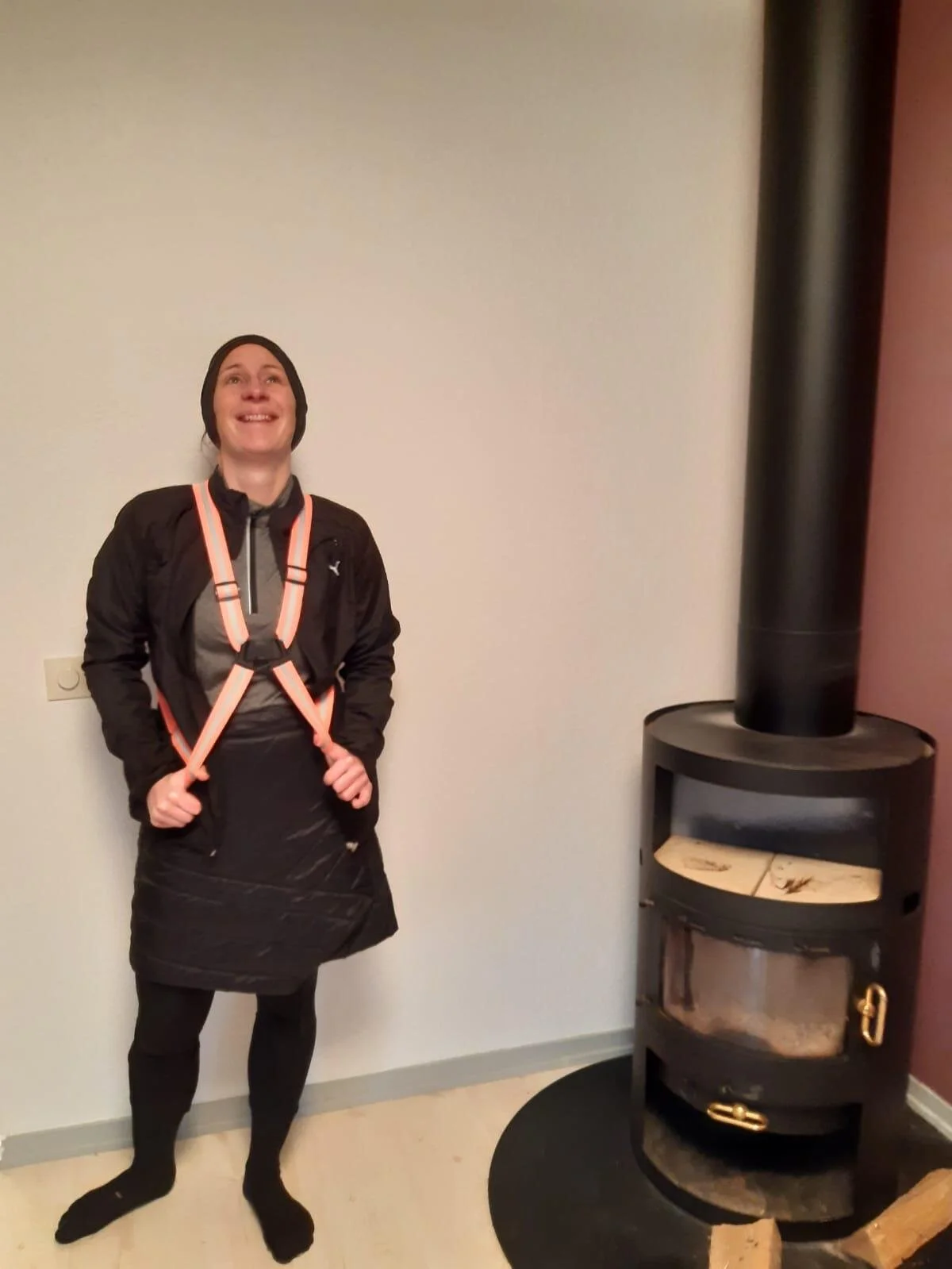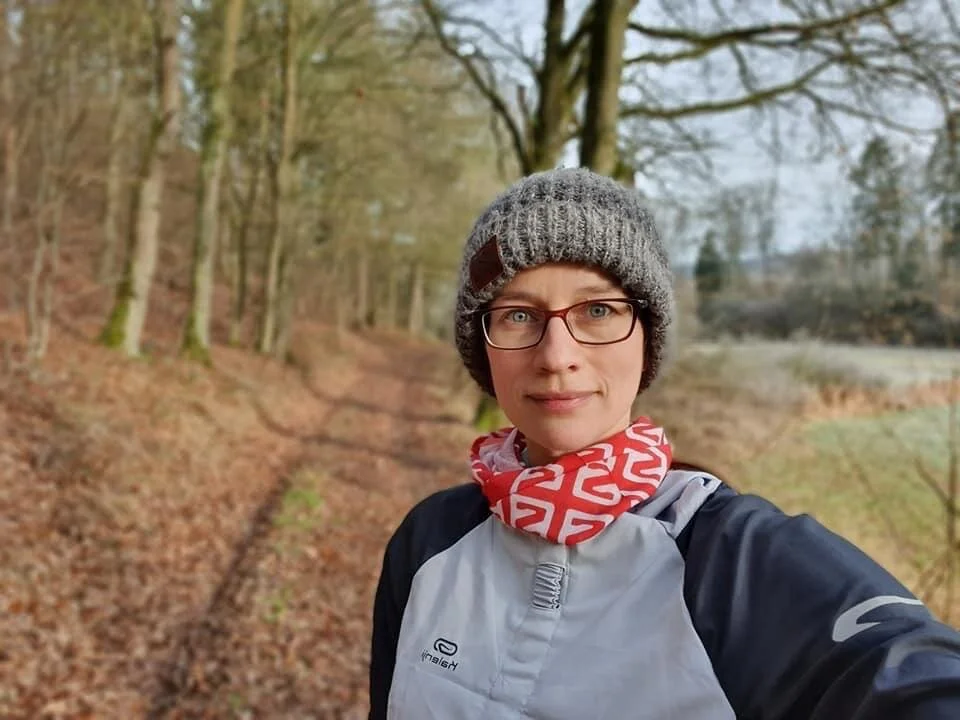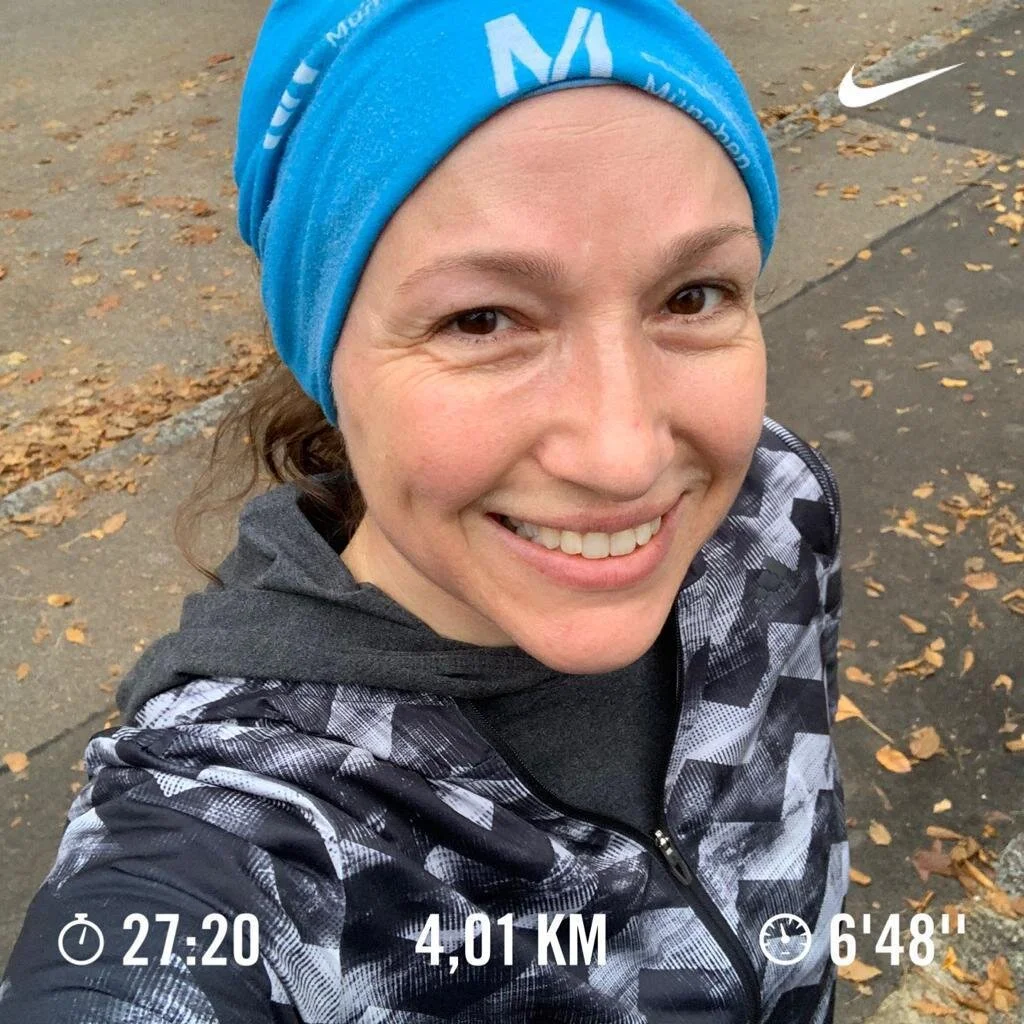A Just Ask Tante Pia column
By Pia Johansson and Jordan Sapir
Calling all novice and professional runners
Last month, Tante Pia received fan mail asking the burning question of this season: How do I stay warm during cold weather running? This month, Tante Pia teams up with Über Moms President, Jordan Sapir, to get all you mom runners prepared for the running season ahead.
Germans say there is no bad weather, just the wrong clothing. So dig out your Turkey Trot Tee, circa 1998 (read further to find out why you shouldn’t do this), and prepare to win this winter, running!
Tante Pia: It is generally not dangerous to run in the cold. Well, not until it gets below -15°C, anyway (even then, not a no-no, but some caution is required). Keep your core and extremities warm and you’ll be fine. If your airways are sensitive to the cold, breathe through a buff. You probably need to wear less than you think, but it's better to have too much on and take it off than to be too cold. But if you feel too warm, do take a layer off, otherwise, you will become dehydrated, no matter how cold it is outside. Also, bring your phone, in case you get lost or injured, and so you can have your bear-proximity app on.
Jordan: With the news of Lockdown Light, you’ve decided to take your fitness routine on the road and start running. You don’t need to spend a lot of money to get started and to be prepared.
There’s a myth that running is a great sport because you only need to lace up your shoes and hit the pavement. Well, that’s true until you become a runner. We runners love our gear and accessories. Don’t be fooled by the simplicity of the sport. Running has a lot of hidden costs. We’re hoping that with this guide, newbie runners and weekend warriors alike can find ways to enjoy winter weather running on a budget.
If you’re new to running, you don’t have to buy new gear; you can use the workout clothes you already have. Remember, our aim is not to win a fashion award. We just want you to stay warm, have fun, and don’t let the temperatures discourage you from hitting the pavement this winter.
From head to toe, here is what you’ll need this season.
Head accessories
Tante Pia: Why is it so important to keep your head and ears warm during your winter runs?
Our ears are sensitive to the cold, both internally and externally. Keep them covered if they hurt. My ears hurt both inside and outside even at quite mild temperatures, so I use a Buff a lot. And any exposed body part will make you lose heat, so if you want to be warmer, put a hat on.
Jordan: For mild temperature runs, I like to keep my ears warm, but don’t like to cover the top of my head, to allow heat to release. If it’s not below zero, I opt for headbands and scarves. Buff brand anything always guarantees you will stay warm and dry. Their materials are breathable and durable.
I also love the Merino Icebreaker, Gore, and the Brooks Thermal running headbands.
Tante Pia: I use Buffs a lot. Around my ears and for breathing through when it gets colder. If it gets really cold, or if it’s a long run, then wool ones are preferable for breathing through (they don’t get as cold and icky as the other ones).
Über Mom Money and Time Saving Hack
Grab that Turkey Trot Tee and sewing machine.
A few other options are available
Jordan: Beanies: Lightweight beanies provide warmth and comfort for runners. I like beanies that are bright, have a rubber grip on the elastic band, and are windproof. Material is key. It may take a few tries to find the right material and style to keep you comfortable. Runners World has a great gear list.
Keeping your core warm is the most important part of cold weather running. You may see professional runners wearing sleeves in the winter with shorts. A lot of runners think the only essential body parts to keep warm are the head and the core. That theory differs depending on who you ask.
Pia: Well, it is actually more about personal preference and genetics if you want long or short sleeves or a hat. But what is important is to keep your core warm. Your core needs to be warm to keep your internal organs working and so the colder blood from your arms and legs can be reheated as it passes through the core. In addition, if your core is warm, it lets more blood flow to your extremities, which is good for running and to keep you warm. If your core is cold, your body will restrict the blood flow in order to minimize further heat loss. This is sacrifice mode: “Better to lose a few fingers than to die.” So in theory, if your core is warm, you are warm. But for some of us (my husband claims I don't generate any heat myself), this is not quite enough, so I help and also warm the rest of me. Indeed, maintaining core temperature conserves energy, so the more you help your body to maintain it, the more you have left for running.
Jordan: Layer, layer, layer. Think of the onion method. My cross country coach used to say to dress for the second mile. You’ll want to check the weather before leaving the house. But beware, too many layers and warm clothing can cause dehydration and overheating. It can also slow you down. My rule of thumb is not to wear more than I can carry if I have to take it off mid-run. What’s important for runners is the temperature, the wind chill, and humidity. Once you have that information, you can decide how many and which layers you’ll wear. The rule of thumb is that polyester and synthetic fibers allow more airflow and dry quickly. This is why you’ll want to save your cotton fun run shirts for rest days.
Here’s some gear to keep in mind depending on the forecast
Base Layer: Short or long top
Jordan: There are loads of styles on the market.
I opt for...
Shirts with a crew neck that can go over my head easily, because I don’t like fumbling with 2 zippers.
I opt out of…
Shirts with holes for the thumbs. I prefer to have that feature on a running jacket or hoodie.
Textiles: Fabric is everything: This is the closest layer to your body, so it’s important that it is breathable, comfortable, and quick-drying.
A long or short-sleeved thin shirt made from synthetic fibers will keep you dry and warm. Merino wool will do the same.
Ventilation is key. We won’t take you down the fabric and breathability rabbit hole (there is one).
Here are some of our go-to brands for shirts
Jordan:
CEP Long Sleeved Running Shirts, Salomon Wool Hooded Long Sleeved Shirt, On weather shirt
Here’s a list from T3 Blog with some other choices:
Pia: When it comes to layers (in addition to the material aspect Jordan covered above), the important thing is that there is room for air between the layers. The air warms up and works as insulation. So don’t wear everything tight, or it becomes just one thick layer. The first layer should be tight, the others not so much.
For winter, I have a Craft underwear set I like. It is long-sleeved and goes up a bit around the neck.
Über Mom Money and Time Saving Hack
Jordan: I purchased a very expensive Patagonia running shirt. I also bought a Salomon long sleeve seamless shirt for half the price. I love them both. What I love even more is that I bought four shirts from Decathlon for the price of one hi-tech brand, and they are equally as comfortable.
There is a lot of equipment in running where quality determines the price. This is not one of them.
To start off running, this is an easy item. Decathlon and Tchibo sports lines have adequate shirts in all styles and sizes. It is nice to have one or two to rotate out.
Bonus: Oftentimes, during races, you’ll need to ditch gear. Having a cheaper brand on hand during race days is called a throwaway. You throw it on the sidelines when you need to ditch a layer. Most races have a lost and found at the end or they donate the clothing to charity following the race.
The Base Layer
Jordan: There are so many options out there for the divide between your body and the elements. I think this is such a personal choice, based on personal body temperature and geographic location.
In New York, winters are brutally cold and humid. The dampness is unbearable. In combination with wind tunnels between buildings, I always felt I needed to leave the house dressed like I lived in the arctic. The weather is a bit different in Munich, so I’ve changed my requirements.
Today, my most valuable winter running item is my jacket.
I favor pockets, a hood, warmth in insulation, and thumb holes in the sleeves.
There are, of course, a lot of pricey items on the market. As a new runner, I encourage you to invest in a quality jacket. With jackets, if you buy cheap, you buy twice. That doesn’t mean that buying an affordable brand is not the way to go. That means that buying a cheaply made jacket means you’ll spend more money in the end. A winter running jacket needs to be warm, durable, and able to withstand the conditions.
We know you might be a proud Jingle Bell Run finisher, but save the 100% cotton hoodie for Hygge at home. Cotton holds moisture. That means you’ll stay wet and cold, which can be uncomfortable and dangerous.
Zippered Jackets
What you’ll want to look for is flexibility, movement, insulation, and breathability.
One of my personal favorites is the Lulu Lemon Another Mile Jacket. The stylish design means I use it on my bike to commute, as well.
A close runner up is my Adidas Response Jacket. It has a great price point, which means I have two I rotate.
Pia: I normally wear two to three layers on top. A tight layer first, then a running jacket on top, and possibly a looser-fitting top in between if it is very cold. I have a light running jacket and a little bit heavier Gore-tex jacket (with more pockets!!). Mostly two layers are enough.
Come back next month for Part 2 of our Guide to Winter Wear for Runners! Leggings, footwear, and more!
Pia Johansson
Pia Johansson is a research scientist in neurobiology, mother of two and working mum. She was an expat for almost twenty years, in Australia and Munich and a short wild stint in Dublin many many years ago. She is in the throes of being repatriated to Sweden with her Australian husband. She likes talking, running and talking about running. And chocolate (although mostly 85% these days, as crazy as that sounds). In addition to staying fit and eating healthy, and raising happy healthy children, she dreams of doing something a little bit creative like writing or becoming a photographer. Or at least organizing her photos soon.
Jordan Sapir
Jordan Sapir, mother of two glitter-laden girls, 3 and 6, studied Journalism and International Political Science in NYC, a place she once called home. She can slaughter five languages fluently. She has worked in a newsroom or two, walked a catwalk or three, and is all for an impromptu adventure. Having traded in her Prada for pretzels, the founder of Über Moms lives in Munich, where she is a stay at home mom and studying to become a certified nutritionist. She is a mommy on a mission and wants to help fellow mothers raise healthy happy families, and beat a PR here and there.








